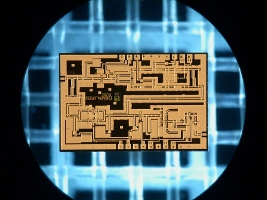 On 6 November 2012, MEP Lambert van Nistelrooij (EPP, NL) hosted a roundtable on the strategic importance of Europe's nanoelectronic sector, co-organised by The Parliament Magazine and ENIAC Joint Undertaking. Michael Sieber, EDA assistant director for research and technology, had been invited to present the defence view on this key technology.
On 6 November 2012, MEP Lambert van Nistelrooij (EPP, NL) hosted a roundtable on the strategic importance of Europe's nanoelectronic sector, co-organised by The Parliament Magazine and ENIAC Joint Undertaking. Michael Sieber, EDA assistant director for research and technology, had been invited to present the defence view on this key technology.
Nanoelectronics are the backbone of many advanced technologies also used in the military context and hence part of the European Defence Agency's Strategic Research Agenda.
While defence and security tasks can be supported quite efficiently in taking advantage from “dual-use” technologies, specific military requirements are driving some of them. In the case of nanoelectronics it is cutting edge performance, reliability and robustness in specific operational environments, multi-functionality, high integration density and low weight. Limited production volumes and access to critical technologies and materials which are subject to export restrictions draw attention to managing technological and industrial dependencies, keeping supply chains in Europe if necessary. Only a sustainable and globally competitive European industrial base can secure future supplies. For next generation Monolithic Microwave Integrated Circuits (MMIC) based on the widebandgap semiconductor Gallium Nitride and the related technologies, EDA projects supported the creation of a comprehensive European supply chain which will be critical for the development and production of the next generation radar, communication and electronic protection defence systems.
Regarding the current “technology drain” and declining Research and Development efforts by European Member States, action may be required in additional areas such as Nano-Electro-Mechanical Systems (NEMS), System-on-Chip, Photonics, Advanced Multifunctional and Conformal Antennas. "Without the nanoelectronics sector there would be no viable defence sector, and without defence, investment in nanoelectronics would not be feasible", said Michael Sieber during the roundtable.
EDA is leveraging its respective efforts with other European institutions (European Commission, European Space Agency), to create synergies and avoid duplication. Participating in the Critical Space Technologies for European Strategic Non-Dependence (CRISP) mapping process for example allows to continuously analyse, assess and determine urgent actions for improving European Technology non-Dependence (ETnD) in this area.
Recommendations and proposed actions of the parliamentary roundtable on nanoelectronics included continuous and sustainable investment in research, supply chains and innovative production. Strategic planning and commitment by policy makers will be as necessary as the development of business cases which combine highly specialised supply chains across EU institutions (defence, security, space, others).
All pictures courtesy of Fraunhofer IAF